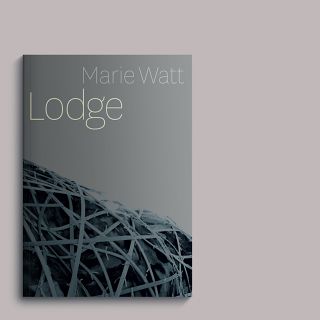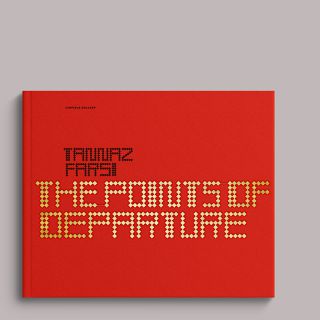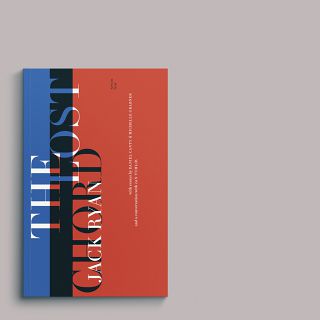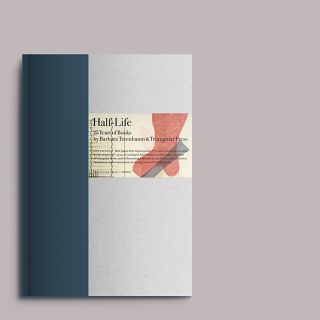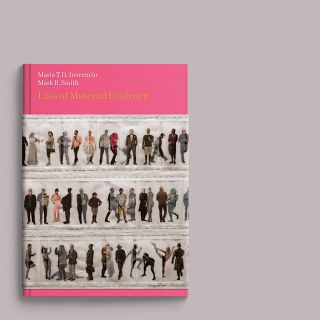Heather Watkins: Recurrent Work
Works
- 2016
- Books / editorial
- Art Gym
- Heather Watkins: Recurrent Work
A compact (64 pp.) survey prepared for an exhibition of the work of Northwest artist Heather Watkins, focusing on installations and drawings created from 2011 to 2014.
The bulk of the book is concerned with Watkins’s experiments with cotton cord of various gauges—from shoelace thickness to that of a garden hose—which she soaks in ink and then sandwiches between two sheets of Japanese paper (or, alternately, a sheet of Japanese paper and a sheet of drafting film), creating two drawing states that she calls transcripts (bottom) and readings (top) in the case of the larger all-paper works, and transmission and residual for those using paper and drafting film.
The ink is left to do its own work, creating strong, muscular drawings on the top sheet and denser, more ethereal marks on the bottom. On the larger works she lets the cord dry in its ink and uses the stiffened result—which she calls a medium—to make large, three-dimensional wall installations.
The images are graphic and powerful. In framing them, we used restrained typography, composed in three sizes of Adobe Caslon, and carefully modulated white space, deployed in an undulating rhythm to harmonize with the forms in the drawings.
Although Recurrent Work was originally planned to be a full-color publication, we noticed that most of the work to be included was monochromatic, with only slight shifts from cool to warm. We ended up printing the images as duotones of blue-black and warm gray, modifying the ratios of the inks to approximate the natural color of a given piece. This was less expensive, of course, but had the additional benefit of being truer to the work.
Illustrations
1.
Front cover

The front cover features a detail of the artist’s Reading No. 4 (2013) . . .
2.
Frontispiece

. . . while the half title uses roughly the same detail of its counterpart, Transcript No. 4 (2013). The book was sewn in wraps, but includes a dust jacket, which dispatches many of the book’s ceremonial duties on its flaps (short biographies, copyright information, and so on), freeing pages that would otherwise be used for more content—an important consideration in such a tight book.
3.
Curator’s notes
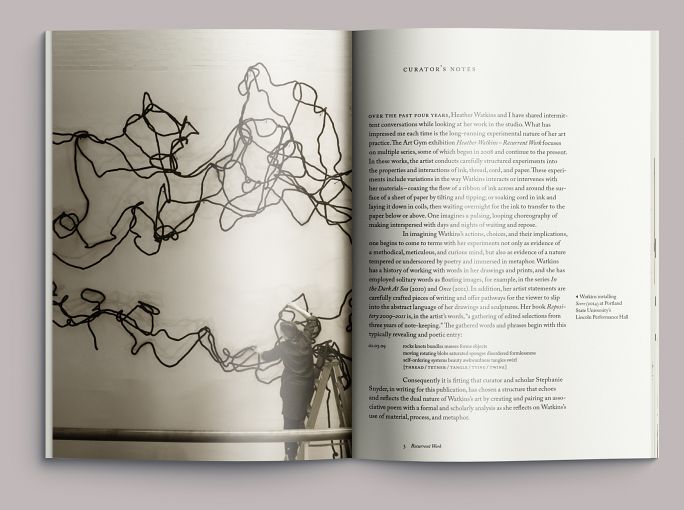
Pages showing treatment of text and sidenotes. The illustration at left shows Watkins installing Score, a large sculptural drawing commissioned by Portland State University that makes use of the inked cords left over from the transcripts and readings.
4.
Full title
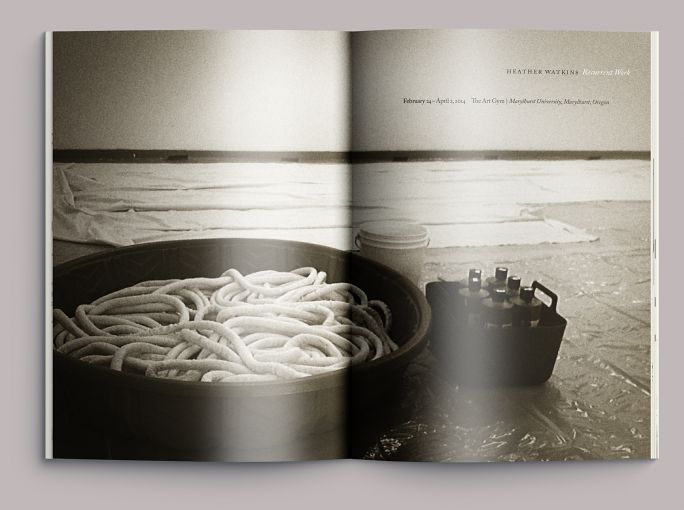
The opening of the book uses many documentary photographs (captured by the artist or her assistants on her iPhone 4s) to give the reader a sense of her process, which is not obvious from the end result. Here, we see some of the cords destined for Score gathered in a vat before being soaked in ink.
5.
Invocation
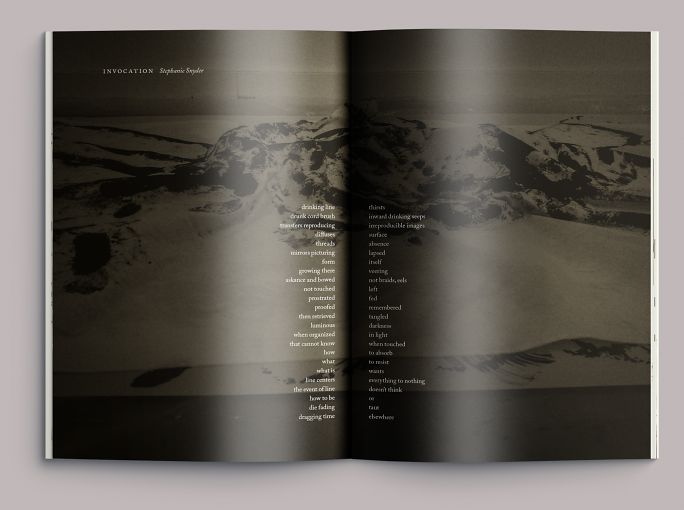
A detail of the transcript/reading process grounds a short poetic piece from critic Stephanie Snyder leading into her essay. Watkins’s conceptual process includes generating similar lists of words and fragmented ideas, a body of which formed her 2012 book Repository, to which we conceived this book as a companion volume.
6.
Essay opening
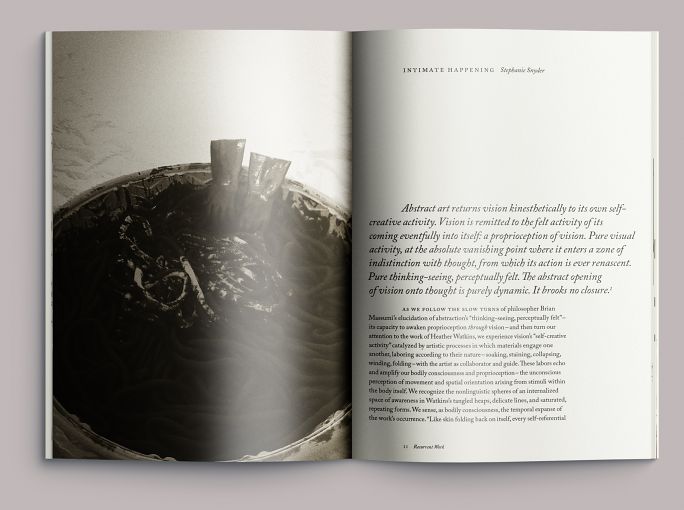
The essay opens with a detail of the inking vat (a large kiddie pool), filled with soaking cords and Watkins’s gloves set against a long quotation from philosopher Brian Massumi on the nature of abstract art.
7.
Essay, continued
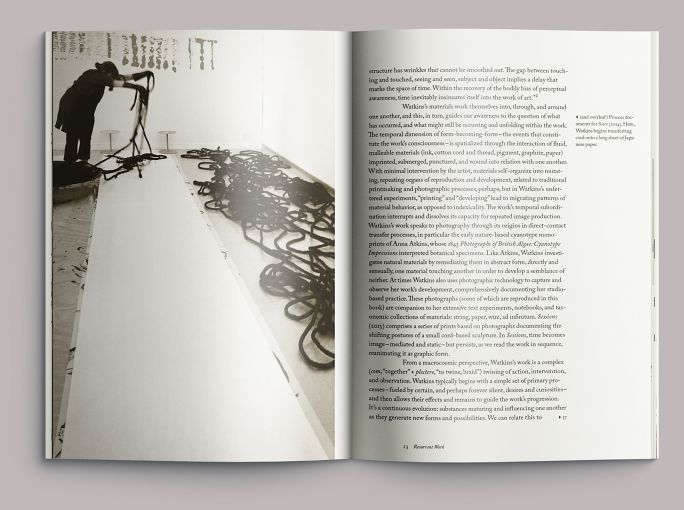
From the inking vat, we see Watkins beginning to arrange the cords of what will become Transcript No. 4 (2013), Reading No. 4 (2013), and, ultimately, a part of the large sculptural drawing Score (2014).
8.
Essay, continued
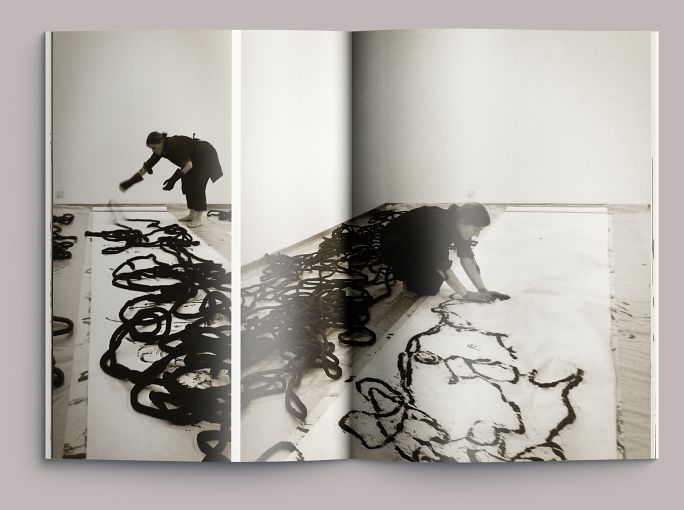
And the work develops. If we’d had room, we would have liked to have run a couple more pages of these images, as it is hard to convey the physicality of the artist’s process. To be sure, the work preserves some of that vitality, but Watkins is not a large person, and the cords are heavy. Working like this requires a great deal of physical stamina as well as attention.
9.
Essay, continued
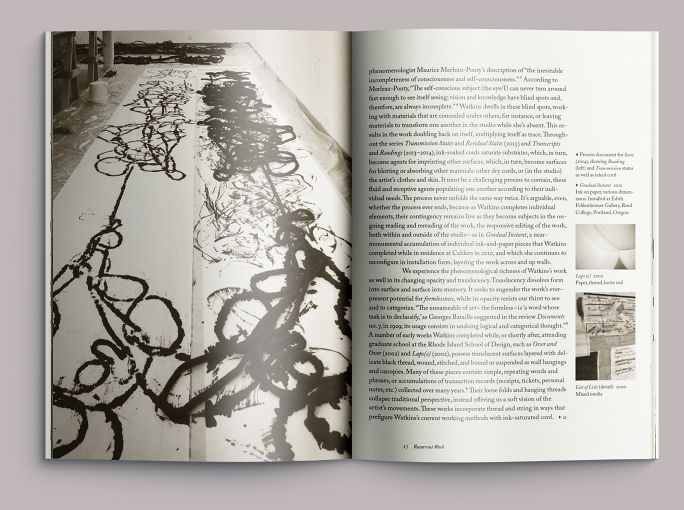
Reading No. 4 and Transcript No. 4 close to completion. The narrow column at right we used for sidenotes and small illustrations of other work mentioned in the essay.
10.
Section opening

Following the essay, the work contained in the exhibition was laid out roughly chronologically and grouped according to conceptual thread. Watkins prepared brief notes for each of these sections. These pages concern Surfacing (2008–11), an earlier group of ink-based action drawings, which is configured differently for each showing.
11.
Section interior
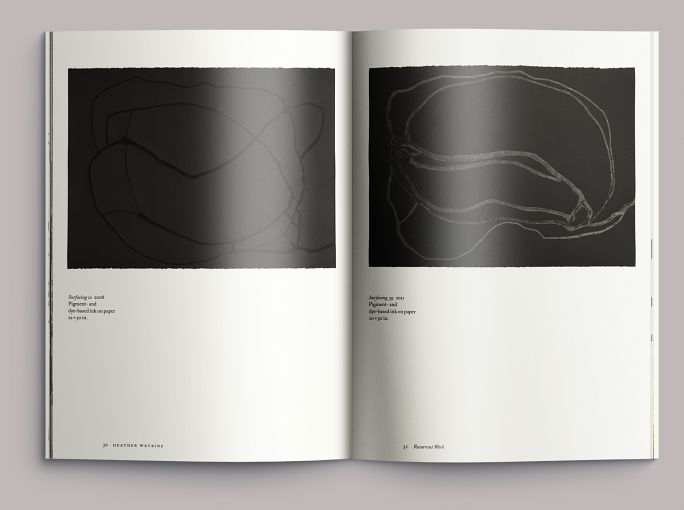
Larger views of two Surfacing works, No. 12 (2008) and No. 39 (2011), showing different characteristics of the work.
12.
Section interior
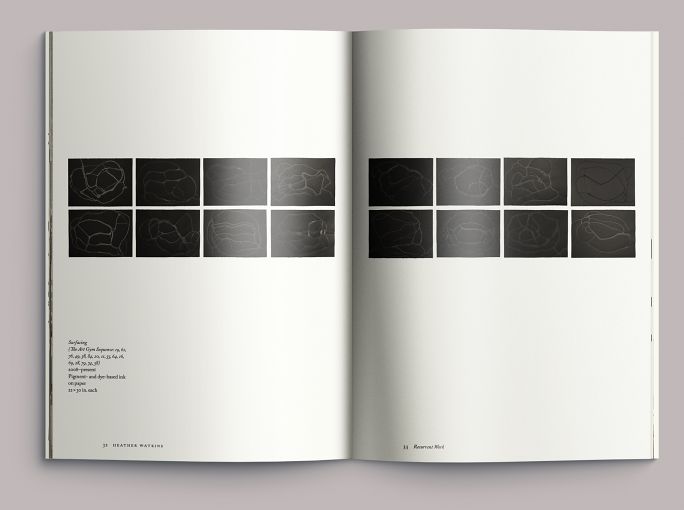
Interior pages showing the version of Surfacing that was installed in the exhibition.
13.
Section opening
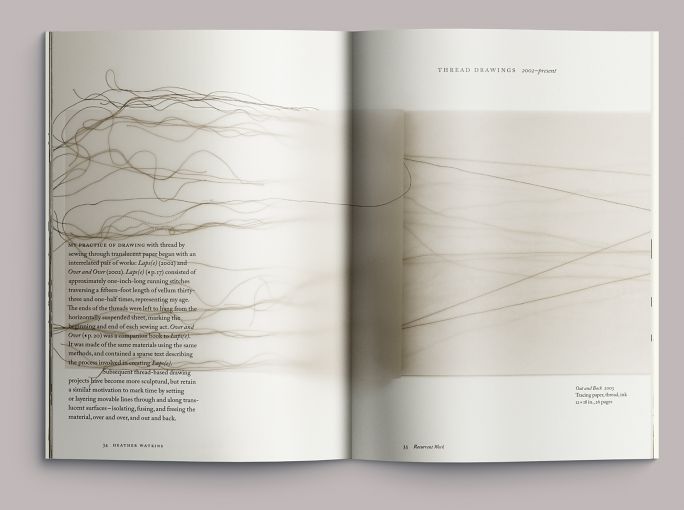
Opening pages for a section exploring Watkins’s earlier thread drawings. There is a fairly rigorous grid underlying this book (derived from common proportions found in the artist’s work), but we exercised flexibility in using it. We’ve written elsewhere about our opposition to solemnity and rigidity in books about the visual arts. These pages violate some of the cardinal rules of such books: the type overprints the image; the headline and copy are on separate pages; and so on.
But as John Berger wrote, you’re not looking at the art, you’re looking at a reproduction. And you’re reading a book, which is quite different from viewing an exhibition. This is a large detail, and in this context, the copy is on equal footing.
But as John Berger wrote, you’re not looking at the art, you’re looking at a reproduction. And you’re reading a book, which is quite different from an exhibition. This is a large detail, and in this context, the copy is on equal footing.
14.
Section interior

Illustrations of Catalysts and Intermediaries, sculptural works made from inked cords once they had dried.
15.
Section opening
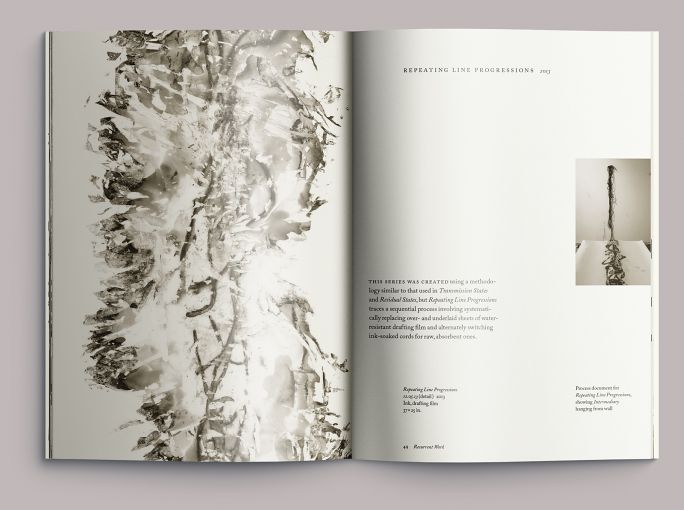
Pages illustrating Watkins’s Repeating Line Progressions, works created on drafting film by systematically replacing over- and underlaid sheets, and alternately switching ink-soaked cords for raw, absorbent ones.
16.
Section interior
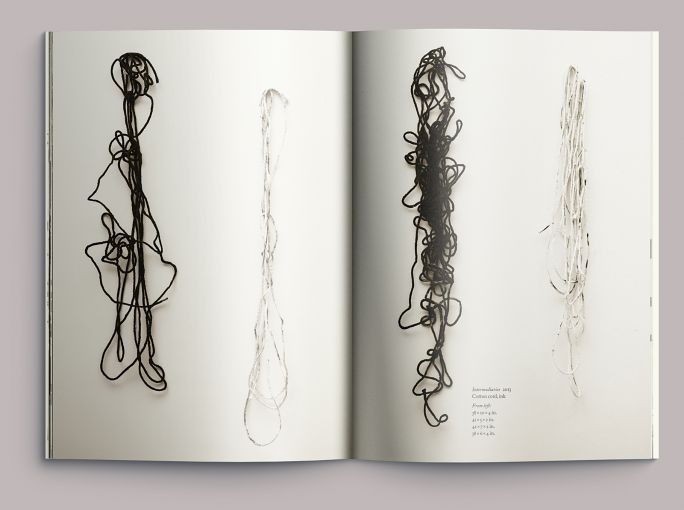
Cords (Intermediaries) used in Repeating Line Progressions.
17
Score
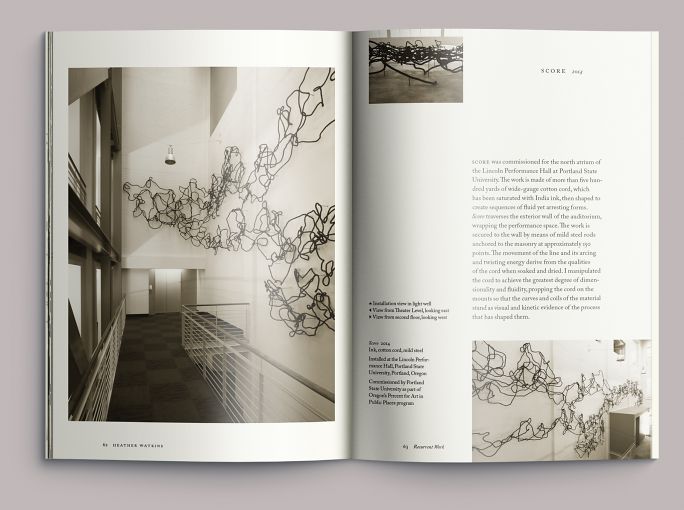
The final pages are given to Score (2014), which, as a permanent site-specific installation, was not included in the exhibition, but which generated much of the work shown. This is a good example of what we call “engaged presentation”: we had neither the room nor the inclination to present these three images in vitrine, each on its own page with a tasteful caption. Rather, we laid them out as you might actually encounter the work, using white space and position to strengthen the point of view of each of the images.
Colophon
64 pp. + cover + dust jacket
7¼ × 10.5 in., ed. 1,000
2-color offset lithography on uncoated paper
Composed in Adobe Caslon
- Essay
- Stephanie Snyder
- Editor
- Allison Dubinsky
- Photography
- Dan Kvitka
Jeremy Bitterman
Evan La Londe
Abigail McNamara
Heather Watkins - Printing
- Brown Printing

